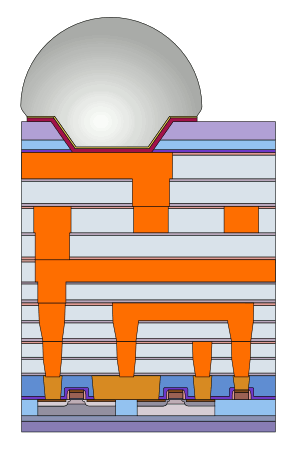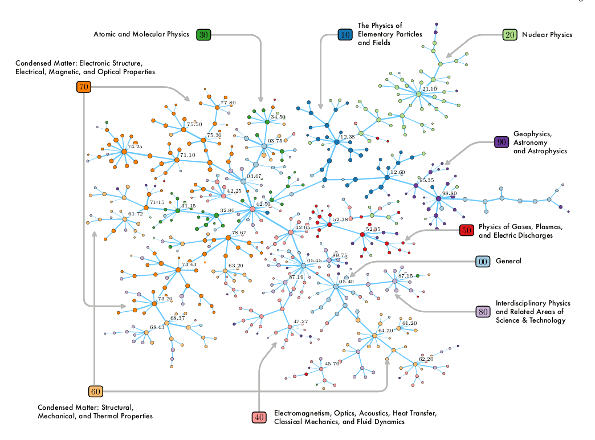Interdisciplinarity in Physics
June 8, 2012
Much of my success in
industrial research came from the diverse training that I obtained during my early years. As a
materials scientist, I was necessarily skilled in a little
chemistry, a little
physics, and a little
engineering. Somewhere along the way, I learned
analog and
digital electronics, which is great when you're a
student trying to get
antique laboratory equipment working; and, I learned
computer programming, which was more fun than work.
The ability to bring many different perspectives to bear on a problem is very useful, especially when your problems involve something as
technologically complex as a
gas turbine engine. The formal term for bringing many scientific disciplines together is called
interdisciplinarity. Fortunately, this practice of creating a whole that's greater than the sum of its parts is much easier than its spelling. How often do you use a nineteen-letter word? That's nearly five,
four-letter words in a row.
A prime example of interdisciplinarity is the creation of
integrated circuits. This field is the convergence of such disparate topics as
quantum mechanics,
chemistry,
crystal growth,
thermodynamics,
optics,
computer science and
metrology. The basics of
physics are nice as a start, but it takes a lot of
technology to transpose such research in the
behavior of electrons in solids into something that allows your child to
video chat with grandma over the
Internet.

I understand how it works, but I still can't understand how they're able to build it with any yield.
Cross-section of a circa 2000 CMOS integrated circuit.
The transistors are at the bottom, and the interconnections are just above them, with copper metalization in orange. The large bump at the top is a lead-free solder ball for attachment.
(Original drawing by "Cepheiden," labels removed for clarity, via Wikimedia Commons)
I wrote about
data mining in a
recent article (Numb3rs, June 6, 2012). A team of
biomedical engineers and
computer scientists from the
Aalto University School of Science in
Finland have applied data mining techniques in a study of cooperation between the sub-fields of physics. They used the
Physics and Astronomy Classification Scheme (PACS) codes of articles published from 1985-2009 as their dataset.
An alphabetical listing of the PACS codes can be found in ref. 1.[1] There you can find everything from
Aberrations (42.15.Fr) to
Z-pinch devices (52.58.Lq), with
musical instruments (43.75.+a) in between. In the PACS scheme, which is a
tree structure, the first
digit specifies one of ten broad categories, while the second digit specifies a subfield of that category. The final characters specify a final subfield.
Unfortunately,
professional associations try to
monetize more than just their journals, and the
American Institute of Physics, which created this
Dewey Decimal System for physics, charges a
licensing fee for the use of PACS.[2] I found this out many years ago, when, as a
referee for an article in the pre-Internet days, I was asked to return a booklet of PACS codes to the editorial office so they wouldn't need to buy another.
The dataset for this study was limited to American Physical Society publications appearing in
Physical Review (A, B, C, D and E),
Physical Review Letters and
Reviews of Modern Physics. If a paper contains two different PACS codes, then it's assumed that there's a connection between these subfields. The maximum
spanning tree representing the 2009 connectivity of subdisciplines in physics is shown in the figure.

The maximum spanning tree representing the 2009 connectivity of subdisciplines in physics, as found from their PACS classifications. Click for larger image. (Fig. 5 of ref. 3, via the arXiv Preprint Server).[3]
The analysis shows that physics has been dominated by condensed matter and general physics in the 1985-2009 period under study. Interdisciplinary physics, however, has been steadily increasing in importance. So, when your
biologist colleague asks you to participate in a study of
inertial navigation in
predatory birds, take him up on his offer.
References:
- Alphabetic Index of the Physics and Astronomy Classification Scheme, American Institute of Physics.
- AIP introduces a new licensing model for PACS, American Institute of Physics Press Release, July 14, 2009.
- Raj Kumar Pan, Sitabhra Sinha, Kimmo Kaski and Jari Saramäki, "The evolution of interdisciplinarity in physics research," ArXiv Preprint Server, June 1, 2012.
Permanent Link to this article
Linked Keywords: Research and development; industrial research; materials science; chemistry; physics; engineering; analog; digital; electronics; graduate student; antique; laboratory equipment; computer programming; technological; gas turbine engine; interdisciplinarity; four-letter word; integrated circuit; quantum mechanics; chemistry; crystal growth; thermodynamics; optics; computer science; metrology; physics; technology; electronic band structure; behavior of electrons in solids; videotelephony; video chat; Internet; yield; CMOS; transistor; copper metalization; orange; lead-free solder; Wikimedia Common; data mining; Numb3rs; biomedical engineer; computer scientist; Aalto University; Finland; Physics and Astronomy Classification Scheme; PACS; aberration; Z-pinch device; musical instrument; tree structure; numerical digit; professional association; monetization; monetize; American Institute of Physics; Dewey Decimal System; license; licensing; scholarly peer review; referee; Physical Review; Physical Review Letters; Reviews of Modern Physics; spanning tree; arXiv Preprint Server; condensed matter; biologist; inertial navigation; predatory bird.